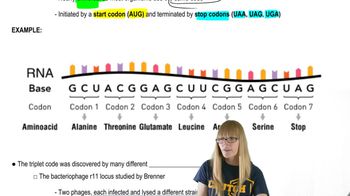How were the specific sequences of triplet codes determined experimentally?
Table of contents
- 1. Introduction to Genetics51m
- 2. Mendel's Laws of Inheritance3h 37m
- 3. Extensions to Mendelian Inheritance2h 41m
- 4. Genetic Mapping and Linkage2h 28m
- 5. Genetics of Bacteria and Viruses1h 21m
- 6. Chromosomal Variation1h 48m
- 7. DNA and Chromosome Structure56m
- 8. DNA Replication1h 10m
- 9. Mitosis and Meiosis1h 34m
- 10. Transcription1h 0m
- 11. Translation58m
- 12. Gene Regulation in Prokaryotes1h 19m
- 13. Gene Regulation in Eukaryotes44m
- 14. Genetic Control of Development44m
- 15. Genomes and Genomics1h 50m
- 16. Transposable Elements47m
- 17. Mutation, Repair, and Recombination1h 6m
- 18. Molecular Genetic Tools19m
- 19. Cancer Genetics29m
- 20. Quantitative Genetics1h 26m
- 21. Population Genetics50m
- 22. Evolutionary Genetics29m
11. Translation
The Genetic Code
Problem 2c
Textbook Question
In the experiments that deciphered the genetic code, many different synthetic mRNA sequences were tested.
What result was obtained for synthetic mRNAs containing AG repeats, that is, AGAGAGAG...?
 Verified step by step guidance
Verified step by step guidance1
Understand the context: The problem involves deciphering the genetic code using synthetic mRNA sequences. The sequence provided, AGAGAGAG..., is a repeating dinucleotide sequence. The goal is to determine the result of translating this sequence into a polypeptide chain.
Recall the codon structure: Each codon consists of three nucleotides, and the genetic code translates these codons into specific amino acids. For the sequence AGAGAGAG..., the codons will be read in overlapping triplets as AGA, GAG, AGA, and so on.
Determine the amino acids encoded: Use the genetic code table to identify the amino acids corresponding to the codons. For example, AG(A) codes for one amino acid, and GA(G) codes for another. Identify these amino acids from the table.
Consider the repeating pattern: Since the sequence is repetitive, the resulting polypeptide will also have a repeating pattern of amino acids. Analyze how the sequence AGAGAGAG... translates into a repeating sequence of amino acids.
Summarize the result: The experiment with AG repeats would produce a polypeptide with a repeating pattern of two amino acids, corresponding to the codons AG(A) and GA(G). This demonstrates how synthetic mRNA sequences can be used to decipher the genetic code.
 Verified video answer for a similar problem:
Verified video answer for a similar problem:This video solution was recommended by our tutors as helpful for the problem above
Video duration:
4mPlay a video:
Was this helpful?
Key Concepts
Here are the essential concepts you must grasp in order to answer the question correctly.
Genetic Code
The genetic code is a set of rules that defines how the sequence of nucleotides in mRNA is translated into amino acids, the building blocks of proteins. It consists of codons, which are triplets of nucleotides, each corresponding to a specific amino acid or a stop signal during protein synthesis.
Recommended video:
Guided course

The Genetic Code
mRNA and Translation
Messenger RNA (mRNA) is a type of RNA that carries genetic information from DNA to the ribosome, where proteins are synthesized. During translation, ribosomes read the mRNA sequence in codons, facilitating the assembly of amino acids into polypeptides based on the genetic instructions.
Recommended video:
Guided course

Translation initiation
Repetitive Sequences and Codon Bias
Repetitive sequences, such as AG repeats, can influence the translation process due to codon bias, where certain codons are preferred over others in different organisms. This can affect the efficiency and accuracy of protein synthesis, potentially leading to variations in the resulting polypeptide chains.
Recommended video:
Guided course

Sequencing Difficulties
Related Videos
Related Practice
Textbook Question
463
views
1
rank


